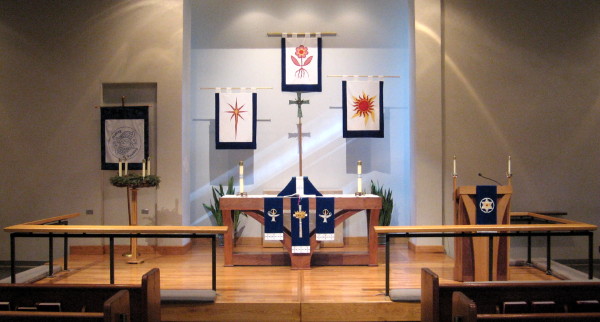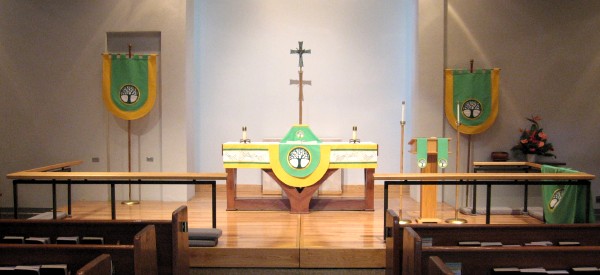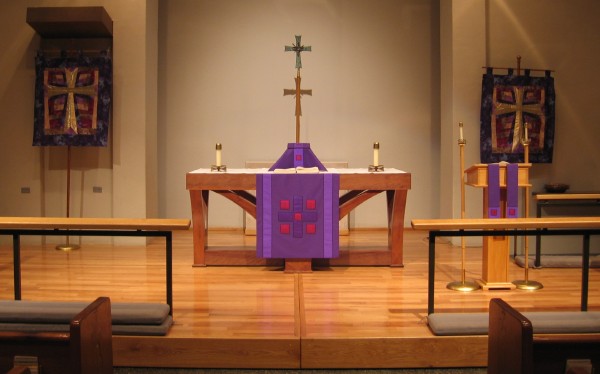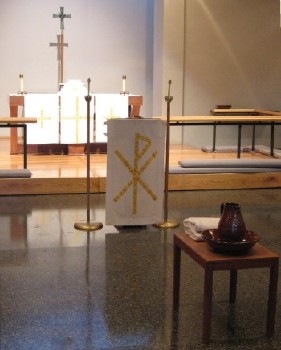- Advent Paraments
- Advent Procession Banners
- Christmas Paraments
- Green Paraments (“Tree of Life”)
- Green Paraments (“Wheat and Grapes”)
- Hawaiian White Paraments, Vestments, and Banners
- Ash Wednesday Paraments and Vestments
- Lenten Paraments, Vestments, and Banners
- Holy Week Paraments and Banner
- Maundy Thursday Paraments (“White and Gold”)
- Red Paraments
These links will take you to explanations of liturgical colors, vestments, and paraments on the ELCA web site.
Paraments, Vestments, and Banners at the Lutheran Church of Honolulu
Advent Paraments

Advent is the start of the church year, a season of beginning and new creation. The color of Advent is blue, which has its roots in the Lutheran Church in Sweden, in the Mozarabic rite, and in the Sarum rite of the Anglican Church. Blue is the color of hope, a primary theme of the Advent Season.
The word Advent is derived from the Latin phrase adventus Domini, meaning “the coming of the Lord.” Often it is understood to refer to the first coming of Jesus. More completely, though, adventus Domini refers to the coming of the Lord in the past, today, and especially at the end of time. The season of Advent, therefore, is a season filled with anticipation and watchfulness.
The LCH Advent paraments were designed by Carl Crosier and fabricated by Roger and Bonnie Smith in 1974.
Beginning in 2009, three of the Advent Procession Banners were hung behind the altar.
Click on any of the paraments in the picture above to view a closer picture and description of that parament, or use one of these links: fasting & feasting Banner | Lectern Hanging | Altar | Advent Procession Banners.
Advent Procession Banners

Traditionally, LCH celebrates the First Sunday of Advent with an “Advent Procession.” The service always includes lessons and music recounting salvation history, and these are frequently organized around the seven “O” Antiphons. The antiphons date from as early as the ninth century and were used before and after the Magnificat at Vespers on the days preceding Christmas (December 17–23). Each antiphon presents a name given to Christ in the Hebrew Scriptures and a petition asking for the fulfillment of a scriptural promise or prophecy. The antiphon texts are the basis for the verses of the beloved Advent hymn O Come, O Come, Emmanuel.
In 1989 members of the congregation made a set of banners to go with the “O” Antiphons. Carol Langner and Walter Williams were responsible for design, cutting, and layout; Babymark Hawaii, Inc. (Lois Oda, president) did the appliqué of the designs; and Carol Langner, Walter Williams, Karen Roberts, Sue Haas, Kim McMillan, and Fritz Fritschel did the lining and finishing. Pastor Donald Johnson designed and constructed banner stands; and Randy Castello, Jimmy Castro, and Fritz Fritschel assembled and painted the stands and candlesticks.
Click on any of the banners in the picture above to view a closer picture and the corresponding antiphon in Latin and English, or use one of these links: O Sapientia | O Adonai | O Radix Jesse | O Clavis David | O Oriens | O Rex Gentium | O Emmanuel.
Christmas Paraments

The season of Christmas—which begins with the celebration of our Savior’s birth on Christmas Day and continues for twelve days until the Epiphany—is a season of joy and light. The color is white.
The LCH Christmas paraments were made by Carol Langner and Jeanne Wiig in 1976. They created them in the LCH kitchen and courtyard using a batik wax resist dyeing technique.
The picture above shows the altar with its Christmas array, which has three medallions. A different array with two medallions is used for the Epiphany. (Pictures of both arrays can be seen by clicking on the altar in the picture above or the Altar Frontals link below.)
Click on any of the paraments in the picture above to view a closer picture and description of that parament, or use one of these links: Christmas Banner (left) | Nativity Scene | Altar Frontals | Lectern Hanging | Christmas Banner (right).
Green Paraments (“Tree of Life”)

Green is the liturgical color for the Sundays after Epiphany and after Pentecost. Because it is the color of growth in nature, green symbolizes our growth in Christ. It is, in a sense, a “neutral color,” used when more festive or more somber color is not appointed.
The “Tree of Life” green paraments were designed in the early 1970s by David Hormann, who was in high school at the time. David also did most of the sewing with help from his mother Astrid. The design combines two different symbols, fish and the Tree of Life. Early Christians used the fish as a symbol for Christ because the Greek word for fish (ichthus) is an acrostic of the phrase “Jesus Christ, Son of God, Savior.” The Tree of Life appears throughout Scripture from Genesis to Revelation. One distinctive feature is use of the contrasting yellow in the horizontal border of the altar frontal and the burse.
These “Tree of Life” paraments were made to fit the older altar and were reworked by Terry Hiller in 2006 to fit the new altar, which is significantly wider than the old altar. To make up for this difference in width, a yellow semicircular piece was added around the Tree of Life. Yellow was also added around the green background of the banners, which had been considered too small by some.
There are also hangings for the wall behind the altar, but the hanging mechanism was taken down for recent repairs to the alcove behind the altar and has not been reinstalled.
Click on any of the paraments or the vestment in the picture above to view a closer picture and description, or use one of these links: Banner | Altar Frontal and Chalice Veil | Lectern Hanging | Chasuble.
Green Paraments and Vestments (“Wheat and Grapes”)

Green is the liturgical color for the Sundays after Epiphany and after Pentecost. Because it is the color of growth in nature, green symbolizes our growth in Christ. It is, in a sense, a “neutral color,” used when more festive or more somber color is not appointed.
The “Wheat and Grapes” green paraments were made in the mid 1970s for a special Reformation Sunday eucharist which brought together members and clergy from Lutheran churches all over the island of O‘ahu. The design was “compiled and adapted” by Carl Crosier from a variety of sources, and the paraments were fabricated by members of the congregation. In 2005, the green paraments were refurbished by Linda Miller to fit the new altar.
There is also a complete set of matching vestments.
Click on either of the paraments or the vestment in the picture above to view a closer picture and description, or use one of these links: Altar Frontals | Lectern Hanging | Chasuble.
Hawaiian White Paraments, Vestments, and Banners

White is the liturgical color for Easter, Feasts of the Incarnation (Christmas, the Epiphany, the Baptism of Jesus, the Transfiguration), Holy Trinity, All Saints, and the Reign of Christ (Christ the King). However, at LCH, the special Christmas paraments are used from Christmas through the Epiphany.
The LCH white paraments were designed by Randy Castello in 1998 with a Hawaiian quilt motif in mind. The altar frontals were completely hand-sewn and quilted by Mrs. Evelyn Cabral. The yellow/orange cloth in the rear hangings and banners was purchased from a local fabric artist at a craft fair. The designs on those pieces of fabric were created by laying ferns and hula implements on cloth treated with photo sensitive dyes and then exposing the cloth to the sun.
A complete set of matching vestments were made at the same time by Randy’s mother.
The entire set of paraments and vestments were donated by the Castello family.
Click on any of the paraments in the picture above to view a closer picture and description of that parament, or use one of these links: Banner | Altar Frontal | Rear Hangings | Lectern Hanging.
The Nave is especially festive at Easter, with the Paschal Candle and Easter lilies.
Ash Wednesday Paraments and Vestments

Black is the preferred color for Ash Wednesday since it is the color of the ashes to which we will all return.
The Black Ash Wednesday Paraments were originally designed by John Hanley in 1976. They are plain black, each with a grey cross pattée. Plain black dalmatics were added a couple of years later. In 1998, the entire set was refurbished and the crosses appliquéd by Terry Hiller. The chasuble was added at that time, making a complete set of vestments.
The black paraments are used only on Ash Wednesday. However, the black dalmatics are used for the stripping of the altar on Maundy Thursday as well as for the Good Friday Liturgy.
Lenten Paraments, Vestments, and Banners

Purple, as the stark color of repentance and solemnity, is the color of Lent.
The purple Lenten paraments and vestments were given to the church in 1999 by Carl, Kathy and Stephen Crosier in memory of Carl’s mother, Inga-lill Crosier Runquist, who died on Ash Wednesday, March 4, 1981, at the age of 54. They were custom ordered from C. M. Almy and Sons. The full set consist of an altar hanging, 2 lectionary bookmarks, 3 stoles, 1 deacon stole, cope, chasuble, dalmatic, and tunicle.
The banners were fabricated in 2003 by Linda Mizuno.
Click on any of the paraments in the picture above to view a closer picture and description of that parament, or use one of these links: Banner | Altar Frontal and Veil | Lectern Hanging. Follow this link to see the vestments.
Holy Week Paraments and Banner

Because it suggests the deep color of blood, scarlet is the preferred color for Palm Sunday (Passion Sunday), Monday, Tuesday, and Wednesday of Holy Week, and Holy Cross Day (September 14). Although the altar and lectern have been completely stripped at the conclusion of the Maundy Thursday Liturgy, scarlet vestments may be used at the Good Friday Liturgy and at the beginning of the Easter Vigil. The scarlet of Holy Week should be distinguished from the brighter color of red, which is appointed for Pentecost, martyrs’ days, Reformation Sunday, and certain other church celebrations.
The paraments, banner, and stole came about as the result of a bit of serendipity. In February 2009, Carl Crosier saw some liturgical weaving that Juditha Murashige, hand weaver, had displayed as part of LCH’s annual Faith & Arts Sunday. In a subsequent conversation with Juditha, he mentioned that the Worship and Music Committee had for many years wanted to have Holy Week paraments and described the shade of red that was needed. Juditha had woven a large piece of cloth in chenille and metallic thread which matched the shade of red the committee was looking for, so with Linda Miller’s help they cut the cloth and made the pieces for the altar. The paraments were first used on Palm Sunday 2009.
For 2011, a crown of thorns was added behind the cross, and the thorns in the banner were replaced with palm fronds.
There are plans for a complete set of vestements to go with these woven paraments, but at present, there is only one stole, also woven by Juditha Murashige.
Click on any of the paraments in the picture above to view a closer picture and description of that parament, or use one of these links: Banner | Altar Frontals and Veil | Lectern Hanging.
Maundy Thursday Paraments (“White and Gold”)
 This set of white and gold paraments were used for Easter and other “white” festivals (except Christmas) until the new Hawaiian quilted ones were designed by Randy Castello in 1998. Their beauty is in their simplicity. Now they are used on Maundy Thursday and Candlemas (or the Presentation of Jesus in the Temple—February 2).
This set of white and gold paraments were used for Easter and other “white” festivals (except Christmas) until the new Hawaiian quilted ones were designed by Randy Castello in 1998. Their beauty is in their simplicity. Now they are used on Maundy Thursday and Candlemas (or the Presentation of Jesus in the Temple—February 2).
The paraments were designed and fabricated by Frank and Susan Haas in the Spring of 1973, and matching vestments were added in 1976.
Click on the paraments or the pitcher in the picture to the left to view a closer picture and description of that item, or use one of these links: Altar Frontal and Veil | Lectern Hanging | Pitcher and Basin for Maundy Thursday Foot Washing.
Red Paraments

Red—the color of fire—is used on Pentecost, when we remember how tongues of fire descended on the crowd in Jerusalem, and on Reformation Sunday and other celebrations of the work of the Holy Spirit. In contrast to the scarlet of Holy Week, the red of Pentecost is a bright color.
These red paraments vividly portray the tongues of fire in shades of bright red. They were created in 1990 by Diane Fell and Jonathan Johnson using using a batik wax resist dyeing technique on silk. The white underskirt for the altar frontal was made by Carol Langner. The altar frontal was reworked by Terry Hiller for the new altar in 2006.
There is also a set of matching vestments.
Click on individual paraments, either of the banners, or the vestment in the picture above to view a closer picture and description, or use one of these links: Pentecost Banner | Altar Frontal and Veil | Lectern Hanging | “Feeding the Hungry” Banner | Chasuble.
Comments welcome at webmaster@lchwelcome.org